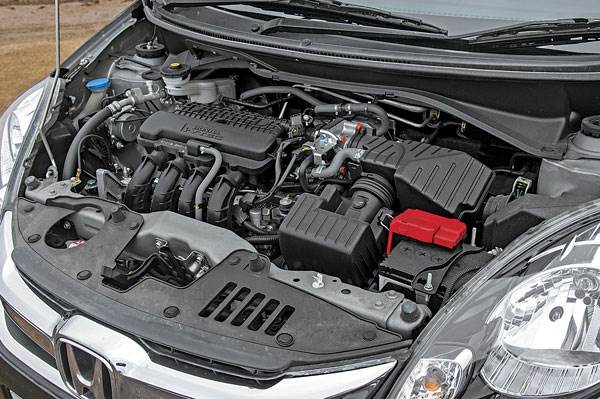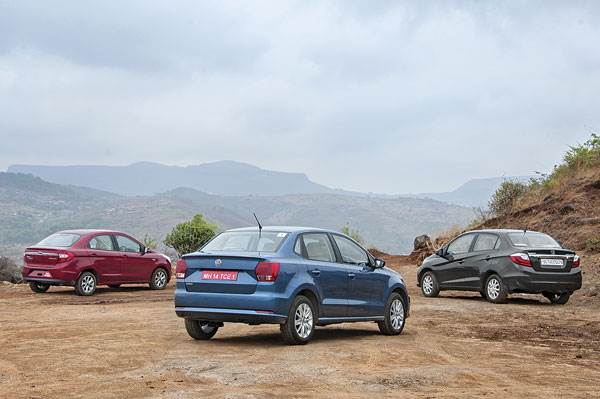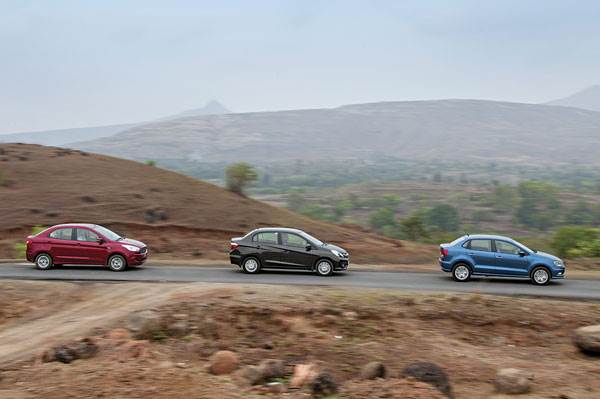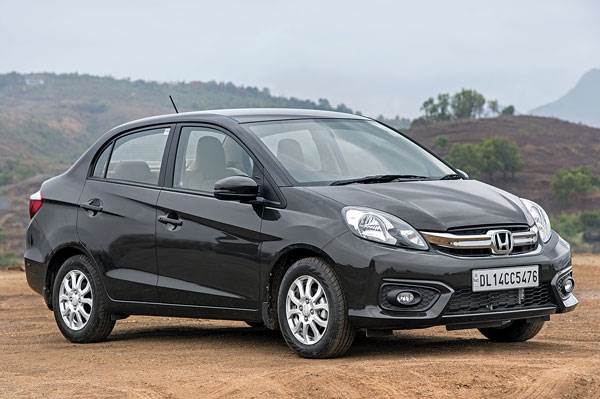You’ve already seen in our review about what VW’s new compact sedan is all about, and now it’s time for it to prove its mettle against the competition. Granted, it’s got some pretty strong and quite well-established rivals in this class, and there are quite a few of them. However, because the Ameo is only available as a petrol for now, we’ve only brought along the best. The Amaze comes with Honda’s rev-happy i-VTEC engine, and for many, that’s a huge draw in itself. But the car has also just been given a facelift that addresses some of its shortcomings. Then there’s the Ford Figo Aspire, which, when it came along, beat out our previous favourite, the Hyundai Xcent, to become top dog of the compact sedan segment. It’s got all the right elements in place, as we’ve already seen, but then, the Ameo is packing some serious heat as well. So, can this latecomer upset the balance in this popular class of cars? Let’s find out.
Three-Box Balancing Act
Let’s face it, any carmaker trying to squeeze a three-box sedan shape into a four-metre length restriction is going to have a hard time balancing good proportions and space. However, it also depends on the starting point from which the compact sedan in question is derived. The Polo was only ever designed to be a hatchback, and though VW has done a commendable job in raking the C-pillar a bit more, squeezing in every last millimetre of length and incorporating a lot of light-catching lines into the boot, the Ameo clearly looks the most awkwardly proportioned of this lot, with the most truncated boot. Still, there are always takers for VW’s characteristically European clean lines and they’re ever present here.

The Aspire doesn’t have as much of a problem as it and its Figo hatchback sibling, were developed alongside one another. So, even though its boot deck does seem quite tall, it’s got the better, more flowing proportions overall. There are some neat new Ford design details that give it a lot of character, like the chrome-slatted grille and the swept-back headlamps, and the result is a car that looks quite muscular despite its small size and tiny wheels.
The Amaze has always been one of the better executed shapes in this class. With the tiny Brio as a starting point, the designers had plenty of room left over to integrate a proper boot onto the back. The facelift has done well to make the car look a little less dowdy than before, and crucially, differentiate it from the Brio. The thick chrome strip on the grille links it to the City and the sharp cuts in the front bumper are nice too. Overall though, it still looks a little plain, lacking the aggression of the Ford or the sophistication of the Volkswagen.
Scooping Out Space
They may all be compact, but because they’re sedans, they’re considered family cars, and so, they have to offer more space than their hatchback counterparts. The Ameo’s engineers, once again, didn’t have a lot of wiggle room in this department and the interior space is virtually identical to the Polo, which wasn’t great to begin with. Though the front seat backs are scooped out, kneeroom at the rear is only just enough, and though the rear AC vents are a nice touch, they will make things a little tight for a middle passenger. The seat itself, however, is pretty good, with a decent amount of comfort and support. It is the only one here without an armrest for rear passengers though.
The Aspire has surprisingly great rear legroom; it really looks like it wouldn’t. There’s good headroom as well, although it isn’t particularly wide, so a third occupant might be a bit of a squeeze. As for the seats, thigh support isn’t the best and the cushioning is a touch on the firm side. But the winner of the space race is the Honda. The engineers have truly scooped every last millimetre out of the cabin, to the point that even some mid-size sedan owners would be happy back here. There’s an armrest, it’s the most suited to three passengers in this lot, and even the seats themselves are the most comfortable and supportive. You also get a tremendous sense of space thanks to the Amaze’s cab-forward design and large glass-house, but that’s also something you can say of the Figo Aspire.
On the subject of space, you can’t leave the boot out, and the new VW, once again, trails behind with just 330 litres. Still, it’s a very usable 330 litres, thanks to a square shape with few intrusions and a loading lip that’s not so high. And then there’s the advantage of a flip-down rear seat, which the other two don’t get. Still, they both get more space overall, with the Ford rated at 359 litres and the Honda at a massive 400 litres.
Dashing In
What it lacks in space, the Ameo’s interior makes up for with that famous German fit and finish, and the best part is, even though this is an aggressively priced car, this hasn’t been compromised. The dashboard design is all too familiar, and a little plain, but that’s what’s allowed it to age so well. Material and build quality are clearly the best in the segment, and the other two can’t even come close. In fact, the Amaze’s interior is screwed together pretty decently; just not as well as the VW’s. But possibly our biggest criticism of the Amaze was a dashboard that looked and felt too cheap and bare-bones, and Honda has responded by drafting in a dash similar to the Jazz and BR-V. It’s a big step up, with nicer, more upmarket dials, and a cleaner design overall. Some might say the Aspire has the most stylish dashboard here, with its winged shape and cool details, though the mass of buttons is a bit overhwhelming. There are also neat touches like the chromed AC controls and sporty steering wheel, but it’s let down by some cheap looking things – the small dials and the cheap-feeling door handles, for instance. Moreover, it doesn’t feel built to last and the plastics are a bit scratchy – the Honda is a bit better, and the VW is miles ahead.

What Honda hasn’t managed to address with the Amaze facelift is the car’s equipment list, which is a real shame, given how quickly carmakers are upping their game. The only updates of note are Bluetooth and automatic climate control, which are now the bare minimum for the class. The Aspire, meanwhile, gets Ford’s clever Sync infotainment system, with voice commands, smartphone apps and an emergency assistance system. It also lets you open the boot from the keyfob. On the safety front, the others get two airbags and ABS, but the Figo Aspire trumps them with six airbags on this Titanium+ variant. Amazingly though, it’s the Volkswagen that has the longest equipment list. It takes the lead with things like a touchscreen with MirrorLink to replicate your smartphone screen, rear-parking sensors and a camera, cruise control, anti-pinch one-touch-operated windows, auto wipers, an auto-dimming rear-view mirror and the rear AC vents. For a brand known to be stingy with equipment, VW has more than made amends with the Ameo.
Pint-Size Petrols
You get 1.2-litre, naturally aspirated petrols with five-speed manual gearboxes in all these cars, the only difference being that the Ameo uses a three-cylinder engine, while the other two have four cylinders each. The Ameo is the heaviest and makes the least power, so it’s no surprise that it’s the slowest accelerating from rest. Trouble is, this 75hp engine doesn’t feel very nice to drive either. It’s perfectly okay ambling around town at middling revs, but that’s all it’s good at – asking for any more than that will put it out of its comfort zone. It also suffers on refinement, with an audible three-cylinder thrum at low revs and once again, higher up.

Compared to the VW MPI engine, the Ford and Honda’s four-cylinder motors are much more flexible, refined and rev happy. The Figo’s new 88hp 1.2 is impressively refined at all but the last few hundred rpm. It’s a bit weak lower down in the rev range, but it’s got a nice strong mid-range to make up for it. That means that although it can be a bit hesitant in stop-and-go traffic, it springs to life once you’re on the move, and if you keep it in the right gear, making smooth progress is easy.
In complete contrast, the Amaze’s engine, in true i-VTEC fashion, has been tuned for great responses off the line, and a manic top-end that encourages you to rev the hell out of it. The mid-range, meanwhile, is relatively weak, and so you could find yourself needing to shift down when climbing a slope, or making a sudden overtake. This is still the best motor overall, though, because while it’s refined and tractable enough at low speeds, it can also be incredibly thrilling if you want to really drive it hard. It’s no surprise then, that the Honda is the quickest car not only in flat-out acceleration, but from a rolling start as well, except in the 40-100kph (fourth gear) run, where the relatively tall gearing makes it the slowest.

Family Dynamics
The great news is that none of these cars rides or handles badly and all offer a good mix to satisfy you behind the wheel or in the back seat. The Ameo is set-up a little softer than the other two, and that means that you do get some float over bigger undulations and a bit of body roll in the corners. The upshot is a ride that’s great at lower speeds, smothering out bumps effectively. The steering is direct, but doesn’t give you a whole lot of feedback.
The Honda Amaze has always been one of our favourite cars to drive in this class, and more than just that engine, it’s got a quick, sharp steering and a well-calibrated suspension setup. It feels a little loose and light on its feet, but provided you’re not going too fast, that can be fun on its own. The ride is a touch on the firm side, but it’s far from being uncomfortable – apart from maybe a little shock when you hit a large speedbreaker, and a bit of up-and-down movement over a rutted road.
The best ride and handling balance comes in the Ford, and that’s no surprise, given the company’s track record. The steering is as sharp as the Amaze’s but has more weight to give you some confidence. The ride is almost as cossetting at low speeds as the Ameo’s, but then, it’s far more stable at higher speeds too. The others come close, but the Figo Aspire is the most enjoyable to push around some bends, and it’s got the best overall comfort as well.
Do-It-Alls
The reason it’s hard to pick a winner is not because these cars are all so capable. It’s because each has a strength or two that’s so much better than the others, we wouldn’t blame you if you picked it for just that.
The Amaze, for instance; if you want space – look no further. Be it in the cabin or the boot, this car is, by far, the roomiest, and it’s also got the most comfortable seats. It’s got the best engine, it’s the quickest and it’s pretty fun to drive. However, the facelift hasn’t properly addressed its main shortcomings – the cabin still doesn’t excite, and the equipment list is far below the new class standard. Moreover, it’s almost the most expensive car here.
The Ameo, on the other hand, has an amazing price, undercutting the other two by around Rs 30,000! And it does this while having the longest equipment list and the most premium-feeling cabin. So, it really makes a good case for someone looking for value, but he will have to make some compromises. The petrol engine isn’t the strongest and if you’re planning to use it as a family car, the rear seat and boot space will leave you wanting. It’ll definitely make a stronger case as a diesel, but we’ll just have to wait until Diwali for that.
The Aspire is not without its flaws. Cabin quality isn’t great and the motor lacks grunt low down, to name two. It does, however, feel like the most complete package here. It’s got the best ride and handling balance, the cabin is very spacious, it’s boot is big enough and though it’s not quite as well equipped as the Ameo, it’s got just about everything you need. Yes, it’s the most expensive car here, but even if you opt for the lower Titanium trim for a more reasonable Rs 6.83 lakh, you’ll be well catered for. To its credit, the new VW Ameo came really close to rising to the top of this food chain, but as an all-rounder, it’s still the Aspire that is our pick.






Comments
Member Login
Personal Details
No comments yet. Be the first to comment.